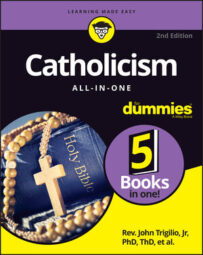While saying the prayers of the Rosary, Catholics meditate on what are called the Joyful, Luminous, Sorrowful, and Glorious Mysteries of the Rosary.
But saying the mysteries is really no mystery at all, because each so-called mystery refers to a different passage in the life of Christ or Mary, his mother. Each decade (an Our Father, ten Hail Marys, and a Glory Be) recalls a different mystery.
The Joyful Mysteries
The Joyful Mysteries are prayed on Mondays and Saturdays, and they remind the faithful Catholics of Christ’s birth. Each decade corresponds with a different mystery. Starting with the Annunciation for the first decade, try meditating on these scenes sequentially with each decade that you say (they may also be said during the entire Christmas season):
- The Annunciation (Luke 1:26–38)
- The Visitation (Luke 1:39–56)
- The Nativity (Luke 2:1–21)
- The Presentation (Luke 2:22–38)
- The Finding of the Child Jesus in the Temple (Luke 2:41–52)
The Luminous Mysteries
In 2002, Pope St. John Paul II added on the Mysteries of Light, also known in Catholicism as the Luminous Mysteries. Pray the Rosary and recall these Mysteries of Light on Thursdays (they may also be said during the season of Advent):
- The Baptism in the River Jordan (Matthew 3:13–17)
- The Wedding Feast at Cana (John 2:1–11)
- The Preaching of the Coming of the Kingdom of God (Mark 1:14–15)
- The Transfiguration (Matthew 17:1–8)
- The Institution of the Holy Eucharist (Matthew 26:17-29)
The Sorrowful Mysteries
In Catholicism, the Sorrowful Mysteries are prayed on Tuesdays and Fridays, and they remind the faithful of His Passion and death (they may also be said during the entire season of Lent, the 40 days before Easter):
- The Agony of Jesus in the Garden (Matthew 26:36–56)
- The Scourging at the Pillar (Matthew 27:26)
- The Crowning with Thorns (Matthew 27:27–31)
- The Carrying of the Cross (Matthew 27:32)
- The Crucifixion (Matthew 27:33–56)
The Glorious Mysteries
In Catholicism, the Glorious Mysteries are prayed on Wednesdays and Sundays, and they remind the faithful of His Resurrection and the glories of heaven (they may also be said during all of the Easter season):
- The Resurrection (John 20:1–29)
- The Ascension (Luke 24:36–53)
- The Descent of the Holy Spirit (Acts 2:1–4)
- The Assumption of Mary, the Mother of God, into heaven
- The Coronation of Mary in heaven
These last two mysteries are inferred by Revelation (Apocalypse) 12:1; Jesus Christ was the source and center of these miraculous events in that He did them for His mother; she did not do them alone. What Christ did for His mom, He will later do for all true believers at the end of time.
Both the divinity and humanity of Jesus are presented in these mysteries. Only God could be born of a virgin, rise from the dead, and ascend into heaven, and yet only a man could be born, get lost, be found, suffer, and die. Meditating on the Joyful, Luminous, Sorrowful, and Glorious Mysteries helps Catholics confirm that Jesus is both divine and human.
Contemplating the time when Jesus was crowned with thorns, scourged with whips, and nailed to the cross — meditating on Jesus’s Passion — convinces the prayerful that those sufferings are real, and only a real man could feel such pain and agony. Yet reflecting on His Transfiguration, Resurrection, and Ascension reminds believers that only God can transfigure, rise from the dead, and ascend into heaven. By praying the Rosary, the faithful reaffirm that Jesus is true God and true man, one divine person with two natures — divine and human.
Just as Pope St. Paul VI did, Pope St. John Paul II reminded the faithful that the Rosary is Christocentric — it focuses on Christ and is more than a Marian (of Mary) devotion.

